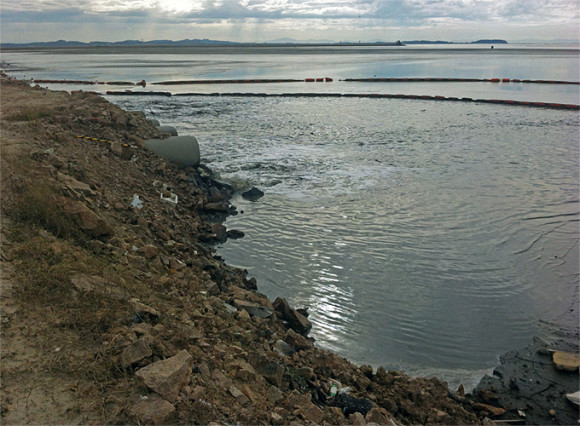Jason Loghry, November 7, 2013
Birds Korea
Last month, Birds Koreans spent several days with the Cornell Lab of Ornithology team at Saemangeum. We found many migratory shorebirds still feeding near some of the non-natural tidal creeks, species such as the Critically Endangered Spoon-billed Sandpiper and the Endangered Black-faced Spoonbill. On these same flats, we also found a small yet alarming number of dead shorebirds all within close proximity of each other.
Saemangeum was once one of the most ecologically rich tidal flats in the world. It is a massive site, an estuarine system that thousands of migratory birds crucially depended on. There were very few places like it in the world. Now, tidal flow has been dammed and it is being converted to dry land and contained water for large-scale industrial use. Closed sluice gates have become an unnatural barrier limiting survival for many East Asian shorebird species historically dependent on these tidal flats during their migration. With the loss of these tidal flats, and others around the Yellow Sea, species like the Spoon-billed Sandpiper are now hurdling towards extinction.
Conservationists, scientists, and teachers are of the many people still trying to spread awareness in hope that policymakers and investors will recognize how destructive this large-scale project is for the natural ecosystem and change its course. Although construction is continuous, companies and infrastructure have yet to be built. Last month marks the first ground-breaking event for infrastructure at Saemangeum. And a chemical firm, Toray Advanced Materials of Japan said, later this year, the company plans to build a new plant to produce polyphenylene sulfide – 80% of which will be exported to our neighbors in China.
Are these the kind of decisions that ensure a sustainable future for this region: eliminating natural assets, crippling historical ecosystems, and replacing them with chemical industry? For many species and their habitat, time is running out. Before more investments are made at Saemangeum, a more responsible plan must be sought. Decision-makers must to take lead on a realistic global green initiative.
 Site still used by shorebirds, but currently being reclaimed for land-use. Saemangeum, October 7, 2013.
Site still used by shorebirds, but currently being reclaimed for land-use. Saemangeum, October 7, 2013.In the news October 2013, about Saemangeum:
October 22, 2013, OCI Co. Ltd. Press Release:
OCI SE Breaks the Ground to Construct Eco-friendly Cogeneration Plant in Saemangeum Industrial Complex
“The facility, with completion due by March 2016, will be the very first company and infrastructure to be located there, Saemangeum Industrial Complex.” It is “to be built on a site of 160,000m2 at a total overall cost of KRW 1.0 trillion, it will supply electricity and steam required for industrial, commercial and residential facilities that will join the complex in near future.
OCI Company has already signed a land purchase agreement for about 4% of the total area of the complex.
The company’s chairman, Lee Soo Young said in his welcoming speech he said that “we expect that this investment will facilitate the entry of other companies from both South Korea and abroad into the Saemangeum Industrial Complex.”
October 8, 2013, Business Korea:
Japan’s Toray to Invest 300 Billion Won to Build Integrated PPS Plant in Korea
“Japan’s Toray Industries and its South Korean subsidiary will invest 300 billion won (US$280 million) in Korea to build a plant capable of producing cutting-edge plastics used in electric cars and aircraft.
Lee Young-kwan, chairman of Toray Advanced Materials Korea, the local subsidiary of the Japanese chemical firm, said the company plans to build a new plant to produce polyphenylene sulfide in volume at Saemangeum Industrial Zone, a massive reclaimed area on the southwest coast.
Out of the total output, 80 percent will be shipped to China.
It will break ground by the end of this year and complete construction before the end of 2015.
An industry source said, however, that such a move by Toray is concerned with its recent trial of acquiring Woongjin Chemical in financial trouble.”
